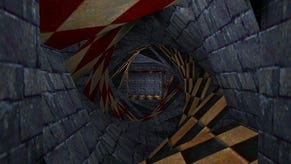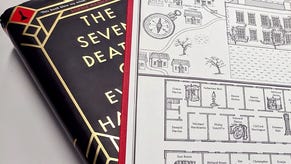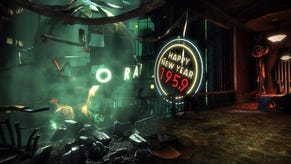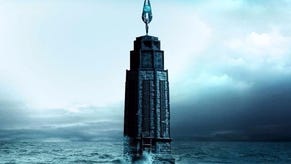BioShock 2: the cutting room floor
Devs talk character design, quest arrows, puzzles and Would You Kindly.
One of the horrible things about going off to see a big game like BioShock 2 is having to cut a lot of the interesting things that the developers say in interviews so your preview is only ridiculously long.
Fortunately, a bit like Heavy Rain last year, there was more than enough said to justify a backup blog post scraping across the cutting room floor. In all we got to speak to half a dozen members of the development team. Here's some of the things that didn't make it into the preview.
The art guys
BioShock 2's senior character designer Colin Fix took up a job at 2K Marin right at the start of development, and got more than he bargained for on his first day, when creative director Jordan Thomas said right you, design the Big Sister.
"I was like, 'Oh my god! You didn't even let me get my feet wet! Okay, the main character!' A lot of her design came from looking at design elements from BioShock 1 and the Big Daddy. Visually we used the Big Daddy vocabulary to try to define her, so she has the basket on her back," he tells me.
"I had one of the Bouncer action figures on my desk and was kind of analysing this thing [gestures twisting it around]. What makes a Big Daddy a Big Daddy? And on the Bouncer he's got the big protective cage on him and I was like, what if I could take some of these elements and deconstruct it and put it on to the Big Sister?
"So the cage, I thought I could put that on her back and twist it. One of the things it serves is it echoes design from the first game and also it serves in function - it's where the Little Sisters ride - and because of that, we started thinking about what a Little Sister would do while she's up there. So I came up with the idea of her doing little drawings and stuff like that on the tank and the back of [the Big Sister's] helmet."
Animation supervisor Jeff Weir, meanwhile, got to work on making the Little Sisters lovable. After all, now you're a Big Daddy, you've got to want to adopt them and look after them, rather than just cutting them apart and eating their ADAM.
"The Little Sister was a really interesting challenge," he says, "in that this time we really wanted to have her story be a lot closer to you, so you'd empathise more with her. We reimagined her model as closer to a real little girl, because in this game you play as a Big Daddy, and we want you to feel that father-daughter empathy. It was really important that felt really acute and tied into it, so you'd want to adopt them."
Fix also worked on the splicer design. The old splicers are back in BioShock 2, but they've had ten years to stew in their own ADAM, and there are new variations too, like the "super-predator splicers", and others we're not shown.
"Initially when I was designing the characters I thought a lot about survival," says Fix. "But when I came to design them they didn't look like part of BioShock, they were more modern or Mad Max-like, so there's this whole interesting thing of trying to push that idea but having to pull it back. Even though a character wouldn't need a fedora for survival, you slap a fedora on him or something like that and certain fashions from the time give it that cohesive look."
That extended to the game's arsenal, too. "In the first game a lot of the weapons were cobbled-together, survival kind of weapons," says Fix. "In this game we want to emphasise that a lot of them were made for Big Daddies... Visually you'll see a few holes and think, 'Something must fit there', and when you get your weapon upgrades you'll see that they do."
The level designers
BioShock was praised, championed and occasionally belittled for its ambitious storytelling, which took in objectivism and all sorts of other things your stupid correspondent barely understands. But it also did a good job of telling that story, partly through little side stories found on tape recorders and also in face-to-face and radio conversations.
"One of the things we are really driving for is getting more sane people in front of the player more often," says lead designer Zak McClendon, who's a sort of sexy Eugene Levy according to Eurogamer style guru Ellie Gibson (sorry Zak).
"It was something that people responded to a lot in BioShock 1 - that there's this incredibly interesting world, and all these interesting characters, and you only get to see brief little snippets of them. Trying to improve the quality of those moments and the frequency they happen... the log storytelling and backstory part of that is definitely still key to the world of BioShock, because there are different kinds of stories you can tell through different moments."
McClendon isn't sure whether he can say if there are multiple endings in this one, mind you, but it seems pretty obvious that it's going in that direction - or rather, that it's going in whichever direction you take it.
"The wider [point] is trying to make sure all those choices are fed back to you over the course of the game," he says, "so that will mean changes in the ending but also letting you make choices that cause differences while you're playing the game."
In light of 2K Boston's BioShock Challenge Rooms for PS3, I ask McClendon and lead level designer JP LeBreton whether that kind of gameplay will feature in BioShock 2. Although they are very nice about it, I get the impression afterwards that this is a stupid question. "Explicitly puzzly stuff? Probably not," says LeBreton. "I think what they were looking at was an interesting branch of BioShock's gameplay, towards the Portal [and other influences]."
(Update: It turns out it was even more of a stupid question than any of us could have anticipated, as 2K has been in touch to say that the 2K Boston team was responsible for the Challenge Rooms, rather than 2K Marin as originally stated. Apologies for the error!)
LeBreton, like McClendon and creative director Jordan Thomas, certainly doesn't want to simplify the game. For instance, I ask about the quest arrows in the first game, which a lot of people slagged off because froth horror this isn't what Looking Glass would have done!
"That was probably one of the deepest vectors for, 'You guys are dumbing this down, you're pandering to the console players' or something," he responds. "But honestly, the way we looked at it was, the people who need that aren't going to be savvy enough to turn it on, but the people who explicitly don't want it, are going to be savvy enough to turn it off.
"And that's something where I hope that super-savvy PC players and those kinds of players can meet us halfway on that, and understand that we're trying to make something more accessible but we are not compromising on some of the stuff that is very important to us."
Plus, of course, I want to know a) how BioShock 2 was going to try and match that "Would You Kindly" moment towards the end of the first game, and b) how on earth they could make a similar sequel with all that in mind.
"This time around we're trying to confront it a little more honestly, and say that an honest limitation is better than a false freedom, for one," says LeBreton. "A lot of the interesting reveals and change-ups about the player's agency in the first game were more opportunistic - it was like Ken [Levine], excellent storyteller that he is, figured out, 'Oh wow, there's stuff in here that's already in the fabric of a lot of games that I can seize on.'
"And I think here we're trying to take that as a ground rule and say, 'OK, well, if we're saying that the player has any kind of free will whatsoever, how do we pay that off breaking the bank development-wise, and how are we honest about what events are immutable', and then the way that it filters down at the gameplay level.
"So yeah, dealing with it more honestly and trying to embrace limitations where we can..." And also, it would be difficult to get away with it a second time. "Yeah, mocking the player while they're playing a game... you can only pull that trick once."
"Would you very kindly," says McClendon.
Jordan Thomas, creative director
I feel like such an idiot interviewing Jordan Thomas. I hope nobody ever hacks my computer and steals the recordings or transcripts and sees all the knots I tied myself in trying to ask about Randian objectivism. It's not very flattering.
Like Gabe Newell and Phil Harrison, Thomas answers serious questions very clearly and intelligently, which is all the more impressive given that he first has to try and work out what the hell I am on about every time he does so.
Fortunately I have a few rubbish ones to throw in first. Where's Jack in all of this, for example?
"Jack's story is over for the purposes of BioShock 2," says Thomas. "The player took him through a long, hard journey and confronted some damned difficult truths about Jack, so Jack has earned his rest, whether it's maniacal or peaceful, and as a redeemer."
And is Fontaine in this one, since it sounds like Ryan is, somehow? "Fontaine is an important part of the texture of the world, but he is very much the BioShock 1 kind of... he's part of the BioShock 1 mystery, let's say. As you saw in the demo, you visit Fontaine Futuristics over the course of the game, so Fontaine as a figure is important cosmologically, kind of, but he is not a main character in BioShock 2. Again, we wouldn't want to invalidate the player's adventure in BioShock 1."
"The parts that we know are common between those two endings are the ones that we are using very specifically in the plot of BioShock 2. We would never want to tell you that neither of your choices happened. So specifically we're focusing on Little Sisters who returned to the surface, and one in particular, who becomes the Big Sister, who was not like the others."
Perhaps my most amazingly fumbled question though is how development is going. You'd think it would be easy to just ask that, but I always ramble on and try and over-elaborate. I think this one ends up being about whether everyone is just colouring in at this point or if it's a more organic process.
"We have to push ourselves or we fall asleep," he says, presumably glad that I am clearly running out of questions. "The fact is that we now know much more about what was successful about 'a BioShock', 'what is a BioShock'. We've answered that question because there's one out there, you can pick it up." (I've played it - it's quite good.)
"From there, the big question is, what's new? And what shape will that newness take? So the fierce debates are always about how much change vs. how much familiarity, how far we can push you in an effort to surprise you vs. how much more of the same are people interested in.
"I think we have to stay organic on the truly groundbreaking axis, because people come to the sequel to a game expecting to be surprised again, but it has helped a lot to have the first game there, and as [lead artist Hogarth Delaplante] said when you guys saw the demo, to critique it properly, and essentially build on the precedent that it set with players who are interested in coming back."
Thanks again to everyone at 2K Marin for spending so much time trying to get me to understand what they're doing. And if I have learned one thing, it is that I will not be one of those games journalists who ends up being a game developer, because talking to game developers makes me look thick.
Check out the main BioShock 2 preview for more.









